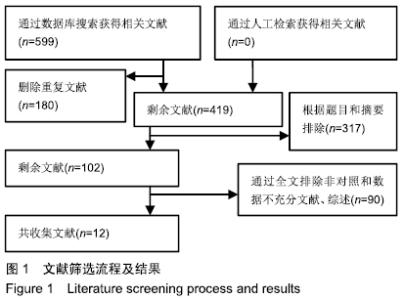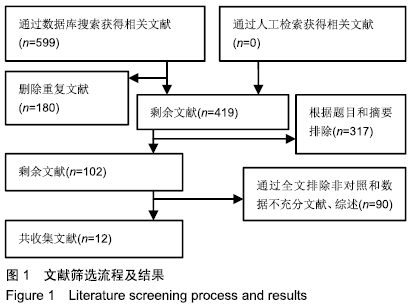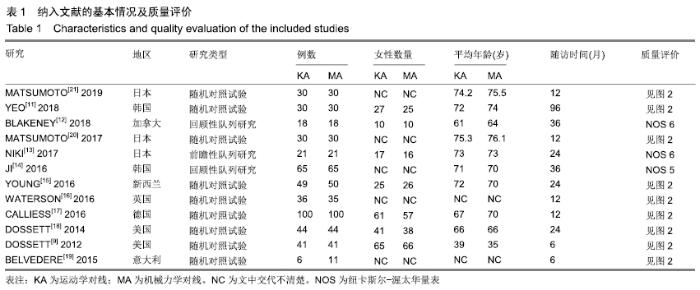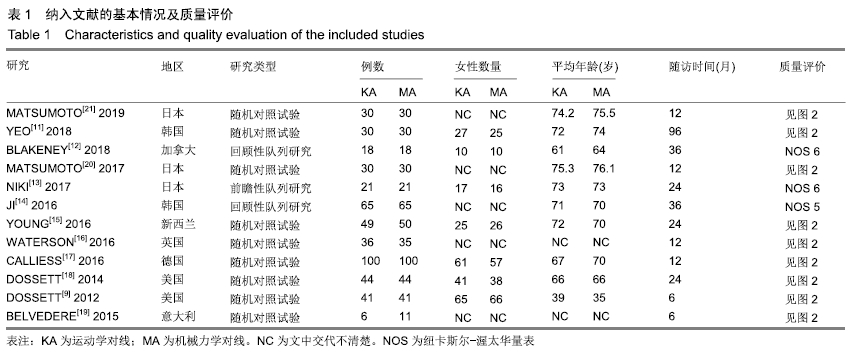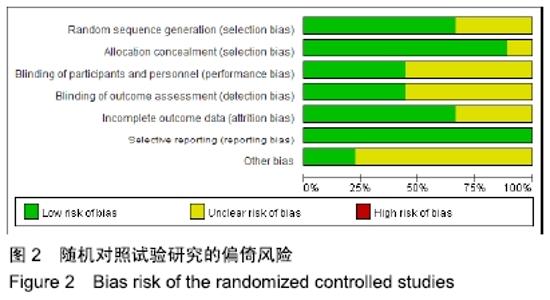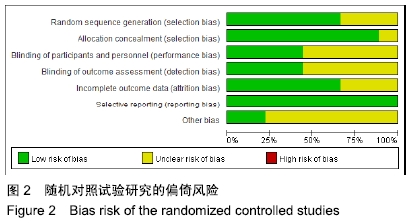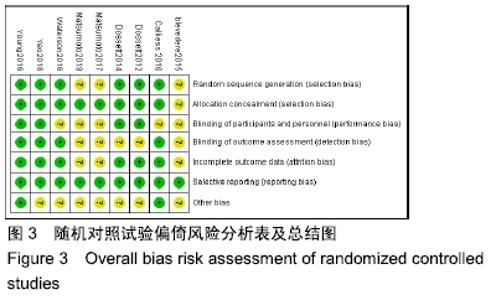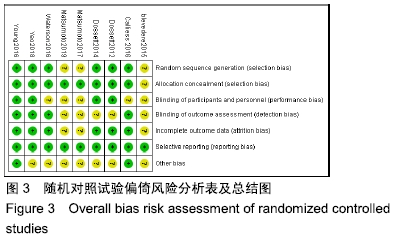Chinese Journal of Tissue Engineering Research ›› 2020, Vol. 24 ›› Issue (9): 1435-1442.doi: 10.3969/j.issn.2095-4344.2494
Previous Articles Next Articles
Meta-analysis of total knee arthroplasty guided by kinematic alignment and mechanical alignment
Zhao Chuntao, Qing Mingsong, Yu Langbo, Peng Jiachen
- Department of Joint Surgery, Affiliated Hospital of Zunyi Medical University, Zunyi 563000, Guizhou Province, China
-
Received:2019-08-01Revised:2019-08-03Accepted:2019-10-09Online:2020-03-28Published:2020-02-13 -
Contact:Peng Jiachen, MD, Chief physician, Department of Joint Surgery, Affiliated Hospital of Zunyi Medical University, Zunyi 563000, Guizhou Province, China -
About author:Zhao Chuntao, Master candidate, Department of Joint Surgery, Affiliated Hospital of Zunyi Medical University, Zunyi 563000, Guizhou Province, China -
Supported by:the Regional Science Foundation Project of National Natural Science Foundation of China, No. 81760400; the Guizhou Science and Technology Support Plan, No. [2018]2760
CLC Number:
Cite this article
Zhao Chuntao, Qing Mingsong, Yu Langbo, Peng Jiachen . Meta-analysis of total knee arthroplasty guided by kinematic alignment and mechanical alignment [J]. Chinese Journal of Tissue Engineering Research, 2020, 24(9): 1435-1442.
share this article
| [1] CARR AJ, ROBERTSSON O, GRAVES S, et al. Knee replacement. Lancet. 2012;379(9823):1331-1340. [2] SCHIRALDI M, BONZANINI G, CHIRILLO D, et al. Mechanical and kinematic alignment in total knee arthroplasty. Ann Transl Med. 2016; 4(7):130. [3] ECKHOFF DG, BACH JM, SPITZER VM, et al. Three-dimensional mechanics, kinematics, and morphology of the knee viewed in virtual reality. J Bone Joint Surg Am. 2005;87 Suppl 2:71-80. [4] BEREND ME, RITTER MA, MEDING JB, et al. Tibial component failure mechanisms in total knee arthroplasty. Clin Orthop Relat Res. 2004;428: 26-34. [5] BAKER PN, VAN DER MEULEN JH, LEWSEY J, et al. The role of pain and function in determining patient satisfaction after total knee replacement. J Bone Joint Surg Br. 2007;89:893-900. [6] BOURNE RB, CHESWORTH BM, DAVIS AM, et al. Patient satisfaction after total knee arthroplasty: who is satisfied and who is not? Clin Orthop Relat Res. 2010;468:57-63. [7] BURNETT RS, BARRACK RL. Computer-assisted total knee arthroplasty is currently of no proven clinical benefit: a systematic review. Clin Orthop Relat Res. 2013;(471): 264-276. [8] HOWELL SM, HOWELL SJ, KUZNIK KT, et al. Does a kinematically aligned total knee arthroplasty restore function without failure regardless of alignment category? Clin Orthop Relat Res. 2013;471(3): 1000-1007. [9] DOSSETT HG, SWARTZ GJ, ESTRADA NA, et al. Kinematically versus mechanically aligned total knee arthroplasty. Orthopedics. 2012;35(2): e160-169. [10] WELLS GA, SHEA B, PETERSON J, et al. The Newcastle-Ottawa Scale (NOS) for assessing the quality of nonrandomised studies in Meta analyses. 2011.http:/www.ohri.ca/programs/clinical epidemiology/oxford.htm. [11] YEO JH, SEON JK, LEE DH, et al. No difference in outcomes and gait analysis between mechanical and kinematic knee alignment methods using robotic total knee arthroplasty. Knee Surg Sports Traumatol Arthrosc. 2019;27(4):1142-1147. [12] BLAKENEY W, CLEMENT J, DESMEULES F, et al. Kinematic alignment in total knee arthroplasty better reproduces normal gait than mechanical alignment. Knee Surg Sports Traumatol Arthrosc. 2019; 27(5):1410-1417. [13] NIKI Y, NAGURA T, NAGAI K, et al. Kinematically aligned total knee arthroplasty reduces knee adduction moment more than mechanically aligned total knee arthroplasty. Knee Surg Sports Traumatol Arthrosc. 2018;26:1629-1635. [14] JI HM, HAN J, JIN DS, et al. Kinematically aligned TKA can align knee joint line to horizontal. Knee Surg Sports Traumatol Arthrosc.2016;24: 2436-2441. [15] YOUNG SW, WALKER ML, BAYAN A, et al. The Chitranjan S. Ranawat Award: No difference in 2-year functional outcomes using kinematic versus mechanical alignment in TKA: a randomized controlled clinical trial. Clin Orthop Relat Res. 2017;475:9-20. [16] WATERSON HB, CLEMENT ND, EYRES KS, et al. The early outcome of kinematic versus mechanical alignment in total knee arthroplasty: a prospective randomised control trial. Bone Jt J. 2016;98-B:1360-1368. [17] CALLIESS T, BAUER K, STUKENBORG-COLSMAN C, et al. PSI kinematic versus non-PSI mechanical alignment in total knee arthroplasty: a prospective, randomized study. Knee Surg Sports Traumatol Arthrosc. 2017;25:1743-1748. [18] DOSSETT HG, ESTRADA NA, SWARTZ GJ, et al. A randomised controlled trial of kinematically and mechanically aligned total knee replacements: two-year clinical results. Bone Jt J. 2014;96-B:907-913. [19] BELVEDERE C, TAMARRI S, ENSINI A, et al. Better joint motion and muscle activity are achieved using kinematic alignment than neutral mechanical alignment in total knee replacement. Gait Posture. 2015; 42:S19-S20. [20] MATSUMOTO T, TAKAYAMA K, ISHIDA K, et al. Radiological and clinical comparison of kinematically versus mechanically aligned total knee arthroplasty. Bone Joint Lett J. 2017;99-B:640-646. [21] MATSUMOTO T, TAKAYAMA K, ISHIDA K, et al. Intraoperative soft tissue balance/kinematics and clinical evaluation of modified kinematically versus mechanically aligned total knee arthroplasty. J Knee Surg. 2019. [22] MUGNAI R, DIGENNARO V, ENSINI A, et al. Can TKA design affect the clinical outcome? Comparison between two guided-motion systems. Knee Surg Sports Traumatol Arthrosc. 2014;22:581-589. [23] HOWELL SM, PAPADOPOULOS S, KUZNIK K, et al. Does varus alignment adversely affect implant survival and function six years after kinematically aligned total knee arthroplasty? Int Orthop. 2015;39: 2117-2124. [24] ECKHOFF DG, BACH JM, SPITZER VM, et al. Three-dimensional mechanics, kinematics,and morphology of the knee viewed in virtual reality. J Bone Joint Surg Am.2005;87(2):71-80. [25] HOWELL SM, PAPADOPOULOS S, KUZNIK KT, et al. Accurate alignment and high function after kinematically aligned TKA performed with generic instruments. Knee Surg Sports Traumatol Arthrosc. 2013; 21:2271-2280. [26] BELLEMANS J, COLYN W, VANDENNEUCKER H, et al. The Chitranjan Ranawat award: is neutral mechanical alignment normal for all patients? The concept of constitutional varus. Clin Orthop Relat Res. 2012;470:45-53. [27] SCHIRALDI M, BONZANINI G, CHIRILLO D, et al. Mechanical and kinematic alignment in total knee arthroplasty. Ann Transl Med. 2016;4: 130. [28] SRIVASTAVA A, LEE GY, STEKLOV N, et al. Effect of tibial component varus on wear in total knee arthroplasty. Knee. 2012;19:560-563. |
| [1] | Hu Kai, Qiao Xiaohong, Zhang Yonghong, Wang Dong, Qin Sihe. Treatment of displaced intra-articular calcaneal fractures with cannulated screws and plates: a meta-analysis of 15 randomized controlled trials [J]. Chinese Journal of Tissue Engineering Research, 2021, 25(9): 1465-1470. |
| [2] | Huang Dengcheng, Wang Zhike, Cao Xuewei. Comparison of the short-term efficacy of extracorporeal shock wave therapy for middle-aged and elderly knee osteoarthritis: a meta-analysis [J]. Chinese Journal of Tissue Engineering Research, 2021, 25(9): 1471-1476. |
| [3] | Wang Jinjun, Deng Zengfa, Liu Kang, He Zhiyong, Yu Xinping, Liang Jianji, Li Chen, Guo Zhouyang. Hemostatic effect and safety of intravenous drip of tranexamic acid combined with topical application of cocktail containing tranexamic acid in total knee arthroplasty [J]. Chinese Journal of Tissue Engineering Research, 2021, 25(9): 1356-1361. |
| [4] | Chen Junming, Yue Chen, He Peilin, Zhang Juntao, Sun Moyuan, Liu Youwen. Hip arthroplasty versus proximal femoral nail antirotation for intertrochanteric fractures in older adults: a meta-analysis [J]. Chinese Journal of Tissue Engineering Research, 2021, 25(9): 1452-1457. |
| [5] | Chen Jinping, Li Kui, Chen Qian, Guo Haoran, Zhang Yingbo, Wei Peng. Meta-analysis of the efficacy and safety of tranexamic acid in open spinal surgery [J]. Chinese Journal of Tissue Engineering Research, 2021, 25(9): 1458-1464. |
| [6] | Wang Yongsheng, Wu Yang, Li Yanchun. Effect of acute high-intensity exercise on appetite hormones in adults: a meta-analysis [J]. Chinese Journal of Tissue Engineering Research, 2021, 25(8): 1305-1312. |
| [7] | Kong Desheng, He Jingjing, Feng Baofeng, Guo Ruiyun, Asiamah Ernest Amponsah, Lü Fei, Zhang Shuhan, Zhang Xiaolin, Ma Jun, Cui Huixian. Efficacy of mesenchymal stem cells in the spinal cord injury of large animal models: a meta-analysis [J]. Chinese Journal of Tissue Engineering Research, 2021, 25(7): 1142-1148. |
| [8] | Yuan Jun, Yang Jiafu. Hemostatic effect of topical tranexamic acid infiltration in cementless total knee arthroplasty [J]. Chinese Journal of Tissue Engineering Research, 2021, 25(6): 873-877. |
| [9] | Huang Dengcheng, Wang Zhike, Cao Xuewei. Intravenous, topical tranexamic acid alone or their combination in total knee arthroplasty: a meta-analysis of randomized controlled trials [J]. Chinese Journal of Tissue Engineering Research, 2021, 25(6): 948-956. |
| [10] | Li Yan, Wang Pei, Deng Donghuan, Yan Wei, Li Lei, Jiang Hongjiang. Electroacupuncture for pain control after total knee arthroplasty: a meta-analysis [J]. Chinese Journal of Tissue Engineering Research, 2021, 25(6): 957-963. |
| [11] | He Xiangzhong, Chen Haiyun, Liu Jun, Lü Yang, Pan Jianke, Yang Wenbin, He Jingwen, Huang Junhan. Platelet-rich plasma combined with microfracture versus microfracture in the treatment of knee cartilage lesions: a meta-analysis [J]. Chinese Journal of Tissue Engineering Research, 2021, 25(6): 964-969. |
| [12] | Hua Haotian, Zhao Wenyu, Zhang Lei, Bai Wenbo, Wang Xinwei. Meta-analysis of clinical efficacy and safety of antibiotic artificial bone in the treatment of chronic osteomyelitis [J]. Chinese Journal of Tissue Engineering Research, 2021, 25(6): 970-976. |
| [13] | Zhan Fangbiao, Cheng Jun, Zou Xinsen, Long Jie, Xie Lizhong, Deng Qianrong. Intraoperative intravenous application of tranexamic acid reduces perioperative bleeding in multilevel posterior spinal surgery: a meta-analysis [J]. Chinese Journal of Tissue Engineering Research, 2021, 25(6): 977-984. |
| [14] | Zhong Hehe, Sun Pengpeng, Sang Peng, Wu Shuhong, Liu Yi. Evaluation of knee stability after simulated reconstruction of the core ligament of the posterolateral complex [J]. Chinese Journal of Tissue Engineering Research, 2021, 25(6): 821-825. |
| [15] | Zhao Zhongyi, Li Yongzhen, Chen Feng, Ji Aiyu. Comparison of total knee arthroplasty and unicompartmental knee arthroplasty in treatment of traumatic osteoarthritis [J]. Chinese Journal of Tissue Engineering Research, 2021, 25(6): 854-859. |
| Viewed | ||||||
|
Full text |
|
|||||
|
Abstract |
|
|||||
